136 Macau (China)
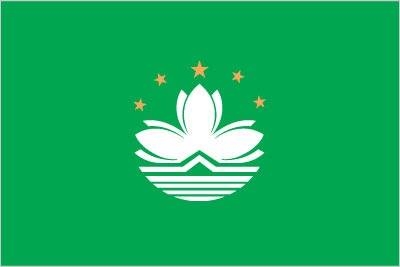
Green with a lotus flower above a stylized bridge and water in white, beneath an arc of five gold, five-pointed stars: one large in the center of the arc and two smaller on either side. The lotus is the floral emblem of Macau, the three petals represent the peninsula and two islands that make up Macau. The five stars echo those on the flag of China.
Flag courtesy of the CIA World Factbook
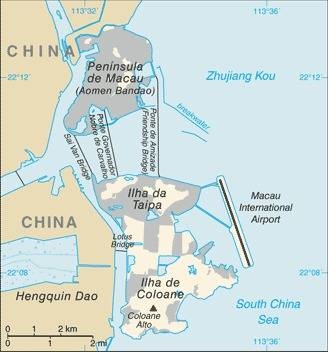
Map courtesy of the CIA World Factbook
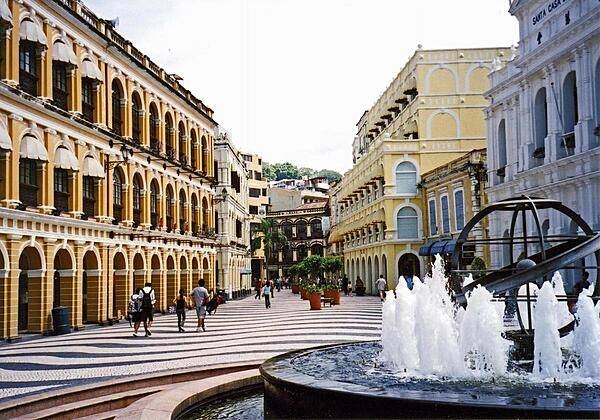
Senate Square with the Leal Senado (Loyal Senate) building on the right.
Photo courtesy of the CIA World Factbook
Last updated on November 23, 2023
Government
According to Britannica, before it became a special administrative region of China in 1999, Macau followed the colonial constitution promulgated in 1976; it was administered by a governor, who in agreement with the Legislative Assembly was appointed by the Portuguese president. With the transfer of sovereignty over the territory to China, the Basic Law of the Macau Special Administrative Region, which outlined a policy of “one country, two systems,” went into effect. For a period of 50 years, Macau will thus retain its capitalist economy and some political autonomy, but foreign policy and defense matters will remain under Chinese administration.
According to the Basic Law, the chief executive, who serves a five-year term, holds executive authority but is under the jurisdiction of the central government in Beijing. An election committee of 300 members, who serve five-year terms, selects the chief executive, who can serve up to two consecutive five-year terms. The chief executive appoints an executive council, which consists of 7 to 11 members, to assist in policy making. The legislature is a single-chamber Legislative Assembly, headed by an elected president and vice president; the assembly has 33 members, who serve four-year terms and are selected by a combination of direct popular election (14), indirect election by a committee of special-interest groups (12), and appointment by the chief executive (7).
Law is based on the Portuguese system. The judicial system was completely administered from Portugal until 1993, when a high court of justice was established in Macau. A new penal code was authorized in 1996 in response to a rise in crime. The Basic Law states that the judicial system remains intact with the transfer of sovereignty and that all judges are appointed by the chief executive. The highest court is the Court of Final Appeal, headed by a chief justice. There are also lower primary courts, intermediate courts, and administrative courts. Macau has a small security force, but defense is the responsibility of the central government in Beijing.
Primary and secondary education in Macau is overwhelmingly at private schools, although the great majority of these schools receive government subsidies. Five years of primary education are officially compulsory, and education is free for children from age 6 to 15. Most receive instruction in Chinese (Cantonese), while the remainder are taught in either English or Portuguese. The University of Macau, formerly the University of East Asia, opened in the early 1990s. In the early 2000s plans were made to move the university from its location on Taipa Island to a parcel of land on China’s Hengqin Island. An agreement for jurisdiction of the land to be transferred to Macau was reached in 2009 as part of a 40-year lease from China. The new campus was inaugurated in 2013, and relocation was completed in 2014. Literacy is now nearly universal in Macau; a slightly larger proportion of males than females is literate.
Civil / National Aviation Authority (CAA/NAA)
The Civil Aviation Authority was established on February 4, 1991 (Decree No. 10/91/M of February 4). It is a public institution with administrative, financial and property autonomy and is subordinate to the Department of Transport and Public Works of the Macau Special Administrative Region. The Civil Aviation Authority is responsible for directing, controlling and supervising civil aviation activities in Macao and the international airspace under the jurisdiction of Macao.
Airspace
SkyVector – Google Maps – ADS-B Exchange
ICAO countries publish an Aeronautical Information Publication (AIP). This document is divided into three parts: General (GEN), En Route (ENR) and Aerodromes (AD). ENR 1.4 details the types of airspace classes they chose to adopt from classes A through G. Macau AIP
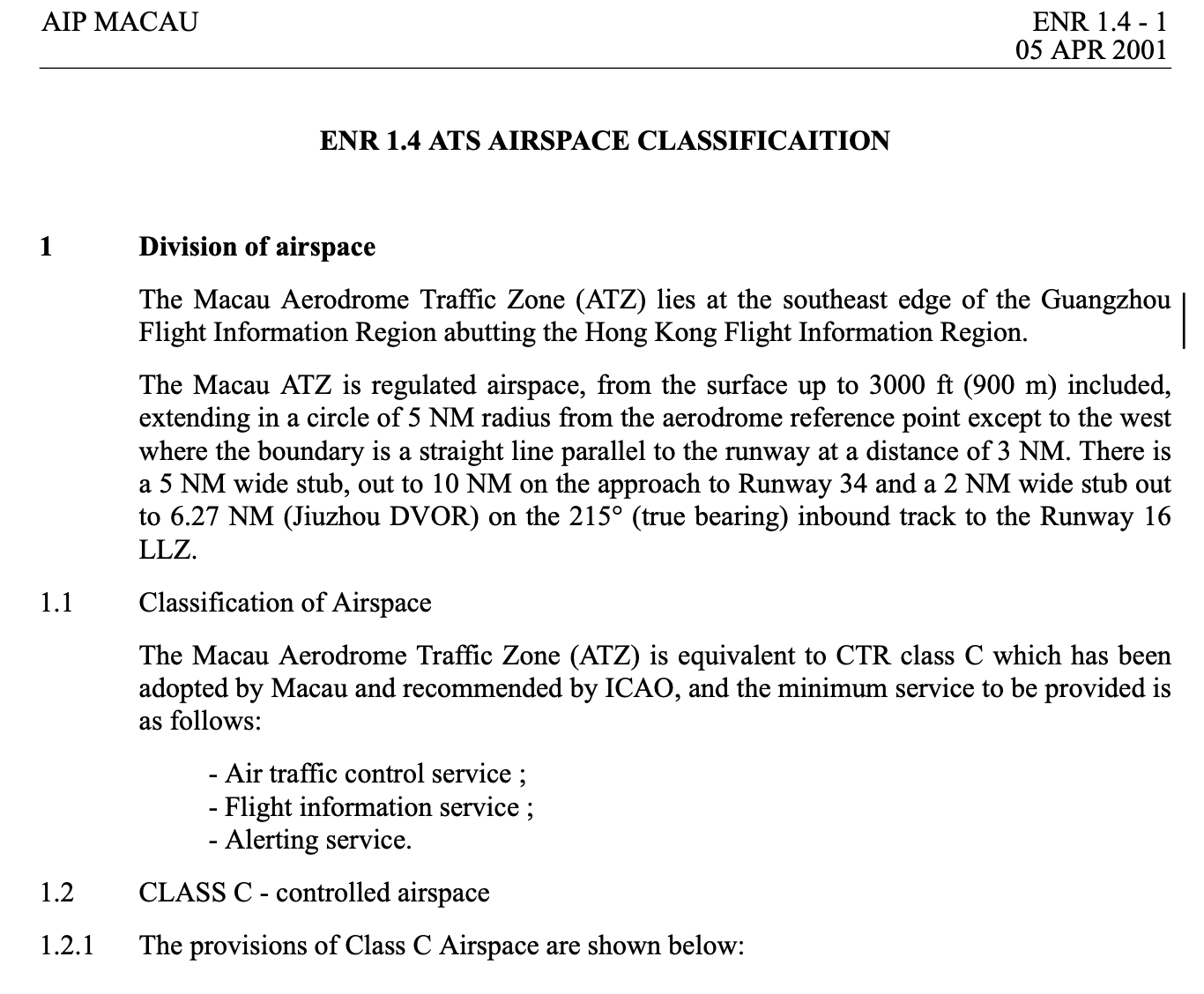
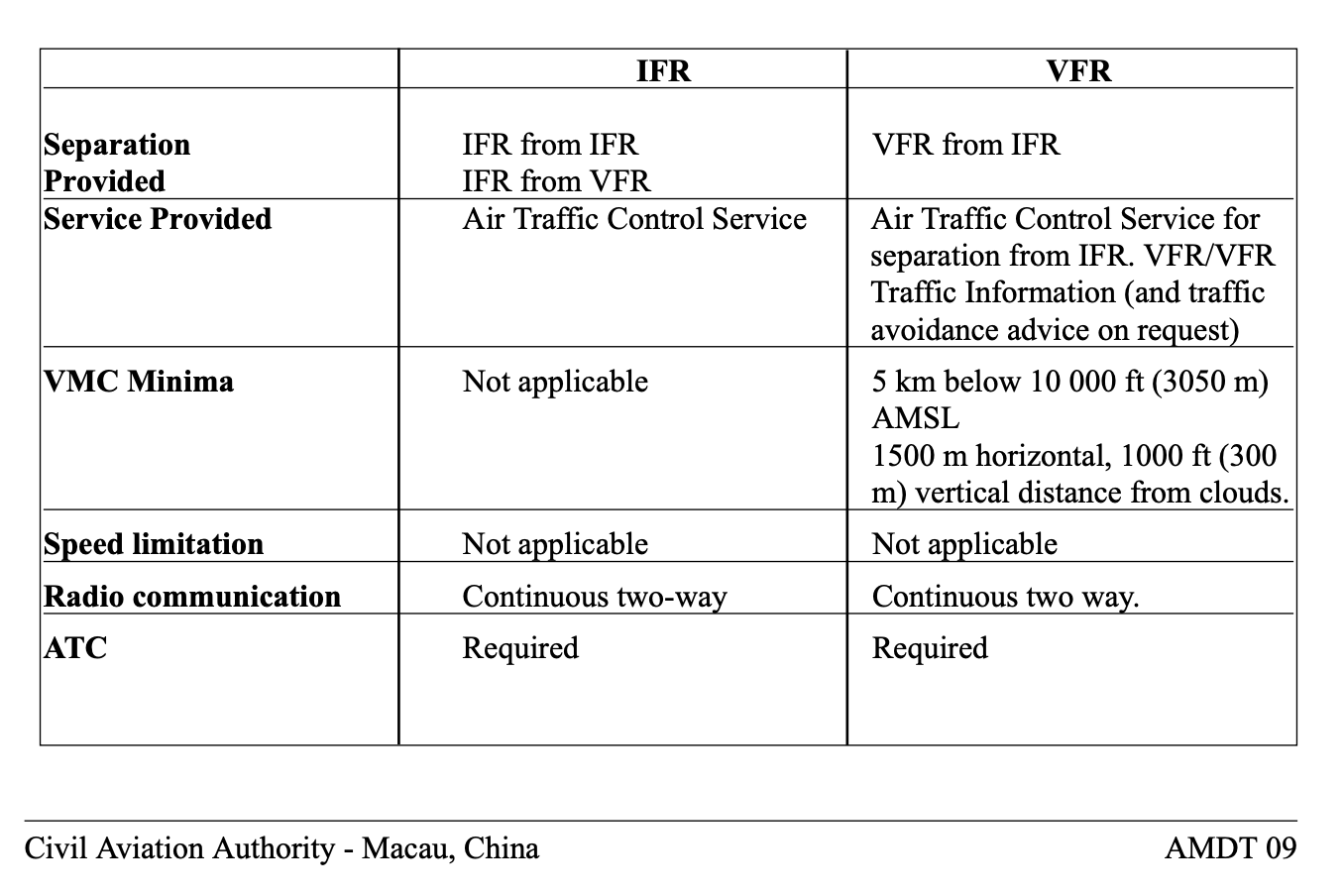
Drone Regulations
Application for an Activity that Affects Flight Safety
Introduction of service – Evaluation and approval for an activity that affects flight safety.
Service target and eligibility criteria
Application procedure for an activity that affects flight safety, examples as follows:
- Flying a captive balloon, a kite, a balloon exceeding two metres in any linear dimension, a hot air balloon, an airship, a glider and an aircraft capable of being flown without a pilot, including unmanned aerial vehicles (UAVs);
- Performing aerial shows, parachutes dropping and acrobatic maneuvers;
- Launching pyrotechnic devices, such as fireworks and rockets;
- Performing an organized release of balloons.
Result
Issue the approval of an activity that affects flight safety to eligible applicant.
Methods of Inquiry
The Civil Aviation Authority of Macao Special Administrative Region (CAA)
Address: Alameda Dr. Carlos D’Assumpção, Centro Comercial Cheng Feng 336342, 18 Andar F, Macau
Tel: (853) 2851 1213
Fax: (853) 2833 8089
Email: aacm@aacm.gov.mo
https://www.aacm.gov.mo
What are the restrictions on operations of unmanned aircraft in Macao air traffic control zone?
In accordance with Part IX Paragraph 67 of the Air Navigation Regulation of Macau, the restrictions on operations of unmanned aircraft in Macao air traffic control zone are as follows:
A person shall not operate any unmanned aircraft, unless the operation is indoors, within the boundaries of a protected area, including:
a) The airspace within 1000 meters of any aerodrome or landing location;
b) Aircraft flight path area defined as the polygonal line with vertices at the points with the rectangular coordinates of Table A on Paragraph 67(b) of this Regulation;
c) The airspace within 50 meters of the Macao Government headquarters, the Legislative Assembly Building, the Court of Final Appeal Building, the official residences of the Chief Executive and principal officials of Macao, the Central People’s Government institutions in Macao as defined by Administrative Regulation no. 22/2000, the Macao Prison, the youth Correctional Institution, the Ka Ho power station and electrical power substations, The Macao Water Supply Company headquarters and the Ka-Ho Fuel farm;
d) The airspace within 50 meters of the 22 classified World Heritage Historic buildings, including: A-Ma Temple (Barra Temple), Headquarters Building of the Marine and Water Bureau (Former Moorish Barracks), Mandarin’s House, St. Lawrence’s Church and forecourt, St. Joseph’s Seminary Building, St. Joseph’s Seminary Church, forecourt and staircase, D. Pedro V Theatre, Sir Robert Ho Tung Library Building, St. Augustine’s Church, Headquarters Building of the Municipal Affairs Bureau (Building of the Former Leal Senado), Sam Kai Vui Kun (Kuan Tai Temple), Headquarters Building of the Holy House of Mercy of Macao, Cathedral Church, Lou Kau Mansion, St. Dominic’s Church, Ruins of St. Paul’s College (Former Mater Dei Church, forecourt and staircase), Na Tcha Temple (nearby the Ruins of St. Paul’s College), Old City Walls (Section in Calçada de S. Francisco Xavier), Mount Fortress, St. Anthony’s Church and forecourt, Headquarters Building of the Orient Foundation (Former Garden House of the Camões Grotto), Protestant Cemetery, Guia Fortress, Chapel of Our Lady of Snow and Lighthouse; and
e) Areas over which the Civil Aviation Authority has restricted or prohibited flying in accordance with paragraph 66 of this Regulation.
In accordance with Provision 16 of Decree Law No. 52/94/M of 7 November, anyone who performs a flying activity in the protection area as set forth in the aeronautical restrictions and does not comply with the above requirements will be liable to a fine of MOP2,000.00 to MOP20,000.00 imposed by AACM.
In addition, the Civil Aviation Authority pointed out that the unmanned aircraft flying activities are not only about aviation safety but also concerning privacy, use of radio, use of venue and so on, anyone who carries out unmanned aircraft flying activities in Macao must comply with relevant regulations and restrictions, and submit the application to the involved government entities in accordance with their regulations and guidelines.
What are the restrictions on operations of unmanned aircraft having a total mass not exceeding 7 kg in Macao air traffic control zone?
In accordance with Part XVI Paragraph 184 of the Air Navigation Regulation of Macau, the restrictions on operations of unmanned aircraft having a total mass not exceeding 7 kg in Macao air traffic control zone are as follows:
A person may operate an unmanned aircraft having a total mass not exceeding 7 kg under the following conditions:
a) the unmanned aircraft does not fly within the boundaries of any protected area specified on paragraph 67. of the Air Navigation Regulation of Macau;
b) the unmanned aircraft flies within the height limits specified on paragraph 184. subparagraph. (2) of the Air Navigation Regulation of Macau;
c) the operation takes place during day time;
d) the unmanned aircraft is not carrying any dangerous substances, including weapons and ammunitions, corrosive, flammable or explosive substances, fireworks, firecrackers, any chemical or biological agent or toxin and any radioactive material or substance;
e) the unmanned aircraft is not discharging anything whether gaseous, liquid or solid;
f) the unmanned aircraft is not towing any object;
g) the unmanned aircraft is not flying within 100 meters of a gathering of 100 persons or more;
h) the UA pilot is on site within 100 meters and with direct control of the unmanned aircraft;
i) the unmanned aircraft is operated under a Visual Line of Sight Operation (VLOS); and
j) the UA pilot is reasonably satisfied that the flight can safely be made.
In accordance with Provision 16 of Decree Law No. 52/94/M of 7 November, anyone who performs a flying activity in the protection area as set forth in the aeronautical restrictions and does not comply with the above requirements will be liable to a fine of MOP2,000.00 to MOP20,000.00 imposed by AACM.
In addition, the Civil Aviation Authority pointed out that the unmanned aircraft flying activities are not only about aviation safety but also concerning privacy, use of radio, use of venue and so on, anyone who carries out unmanned aircraft flying activities in Macao must comply with relevant regulations and restrictions, and submit the application to the involved government entities in accordance with their regulations and guidelines.
Flying activities including drones
Flying activities – According to the civil aviation laws of Macao, that is, Article 6 of Instruction No. 233/95/M amended by Chief Executive’s Order No. 295/2010, any person who wants to fly within the scope of Macao must obtain the authorization of the Civil Aviation Administration of China. written approval. These flying activities include organized flying of a large number of balloons, towed balloons or kites, hot air balloons, Kongming lanterns, or the installation or operation of any outdoor laser lights or searchlights, and air displays, etc.
Apply for balloon release
Download and fill in the “ Application Form for Balloon Flying ”, and submit it by mail, fax, email or in person at the CAAC office.
Unmanned aerial activities
According to the “Macao Air Navigation Regulations” approved by Administrative Order No. 43/2021, anyone who wants to fly drones within Macao must comply with relevant regulations and restrictions. View the “Macau Air Navigation Regulations” and see the overview of the newly revised drone activity requirements in the table below:
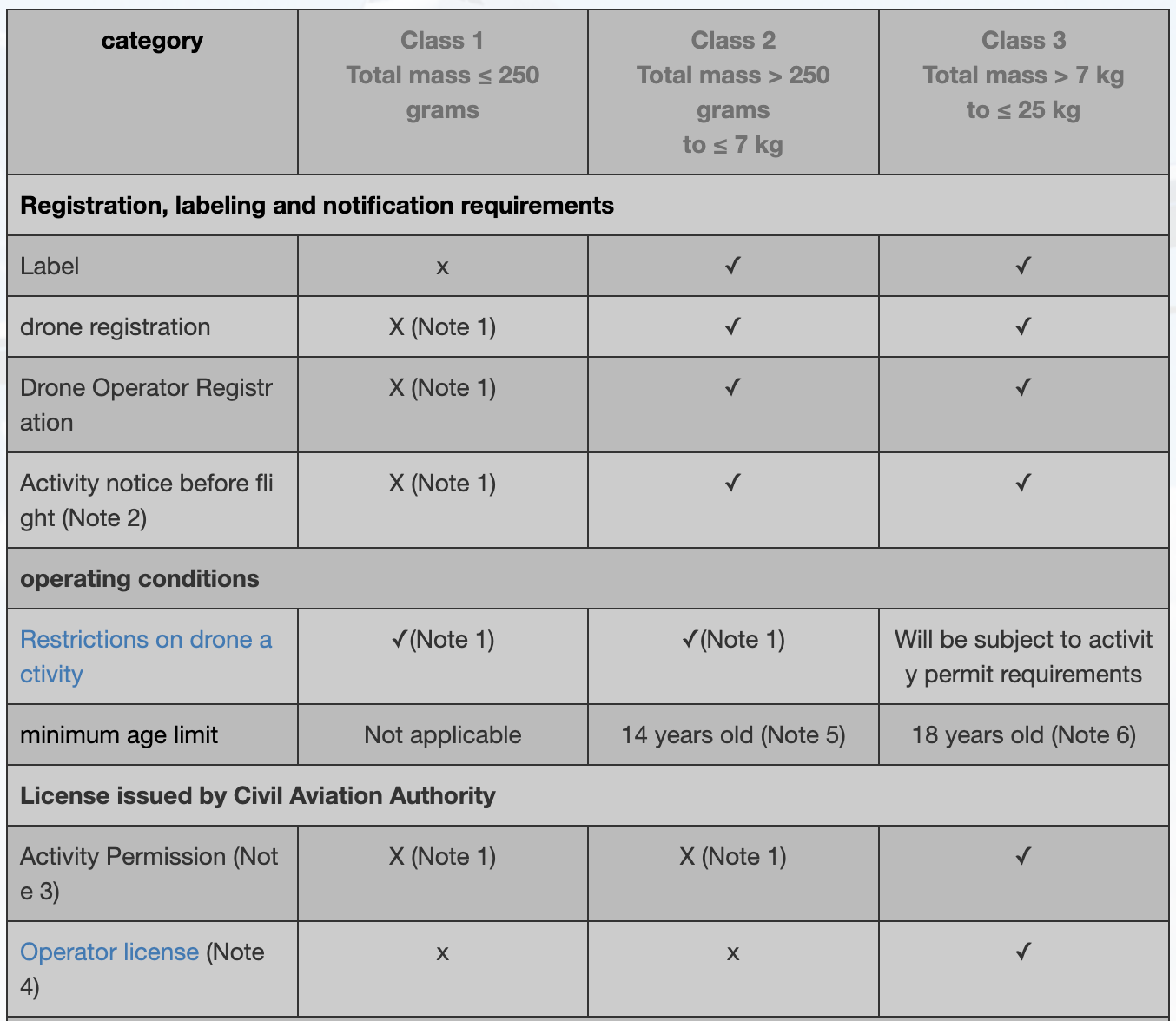
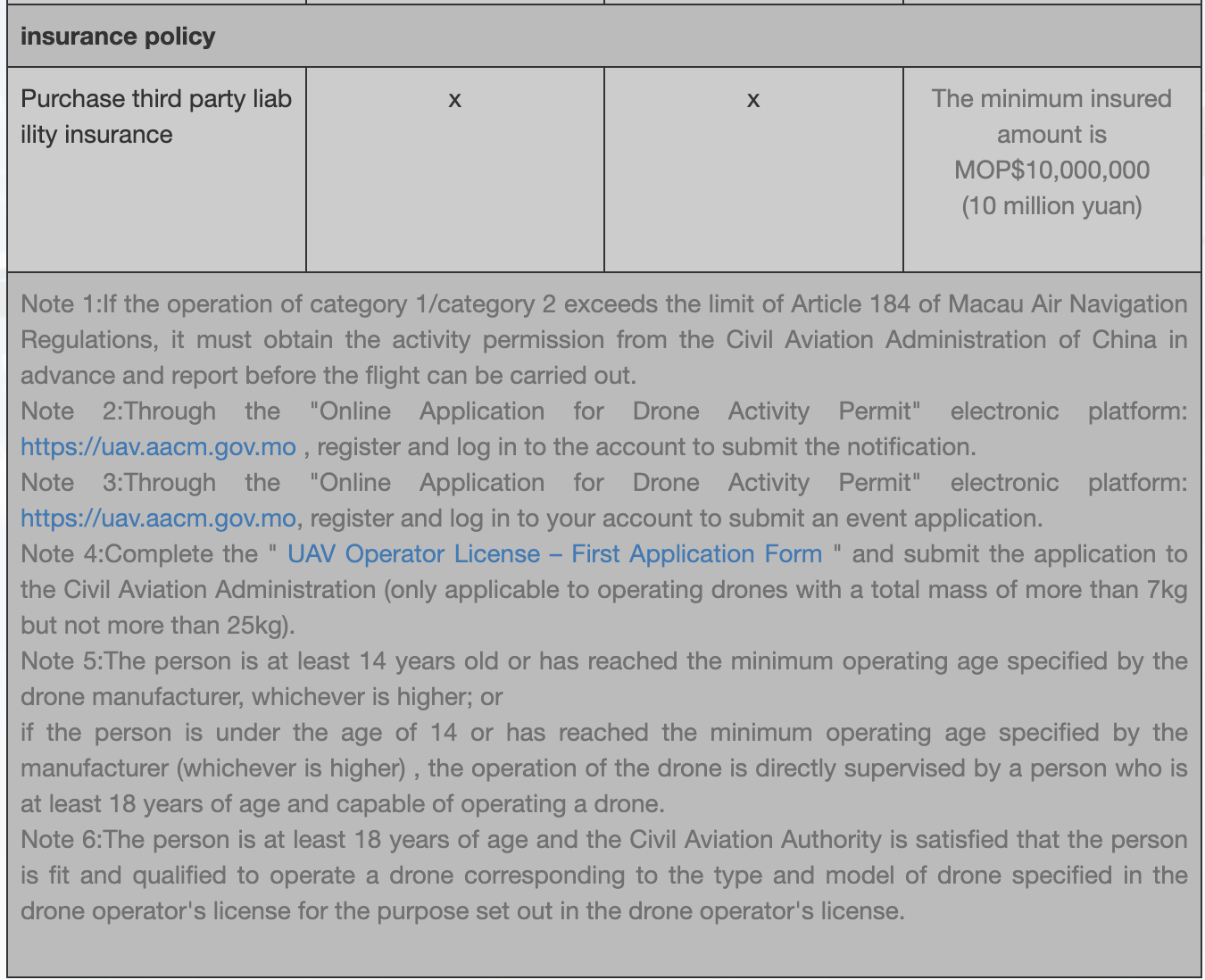
Drone flight map
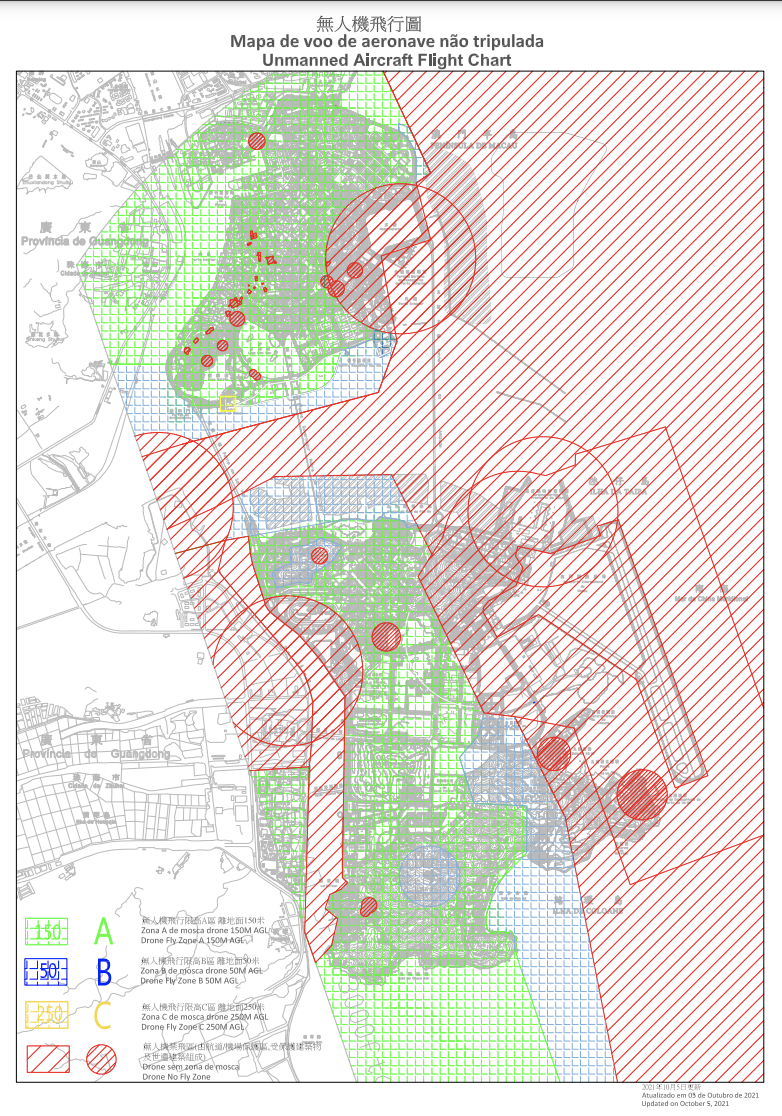
Restrictions on drone activity
According to Article 67 of Part IX of Macau Air Navigation Regulations, unmanned, the restrictions on flying aircraft activities are as follows:
Except indoors, no one is allowed to fly drones within the following protected areas, except for the written permission of the Civil Aviation Administration and other conditions stipulated in the permission:
a) the airspace within 1000 meters of any airport or place of departure and landing;
b) The flight path of the aircraft, which is defined as the column of Article 67(b) of the Macau Air Navigation Regulations
The Cartesian coordinate points in Table A are the areas bounded by the vertices of the perimeter of the polygon;
c) The Macao SAR Government Headquarters, the Legislative Council Building, the Court of Final Appeal, the Chief Executive and the main officials of Macao officials’ residences, Central People’s Government agencies in Macao as defined in Administrative Regulation No. 22/2000, Prison and Juvenile Reformatory, Kauao Power Station and Substation, Headquarters of Macau Waterworks Company and Jiu. Airspace within 50 meters of the Australian Oil Depot; and
d) The airspace within the scope of 22 assessed immovable properties in the World Heritage “Historic Center of Macau”, including Mazu Pavilion (Ma Pavilion Temple), Maritime Affairs and Water Affairs Bureau Building (former site of Moore Barracks), Zheng’s House. The Big House, St. Lawrence’s Church and the Foreground (Fengshun Church), St. Joseph’s Seminary Building, St. Joseph’s Seminary Church, foreground and stone steps, Dome Theatre, Ho Tung Library Building, St. Augustine’s Church, Municipal Administration Building (the site of the former City Hall), Sanjie Guild Hall (Guandi Ancient Temple), Macao Mercy Hall Building, Cathedral (Lobby), Lujia Mansion, Church of Our Lady of the Rosary (Banzhang Church), St. Paul’s College, The ruins of the Church of the Mother of God (Ruins of St. Paul’s, the front ground and stone steps), Nezha Temple (Ruins of St. Paul’s), Remains of the city wall (a section of St. Francis’ Inclined Lane), the Fortress (Central Fort), St. Anthony’s Church Jiqiandi (Kao Hall), the site of the Oriental Foundation (formerly the site of the former Cames Garden House), the Foundation Christian Cemetery, Guia Fortress, Church of Our Lady of the Snow and Lighthouse; and
e) Prohibited or restricted flight areas established by the Civil Aviation Administration in accordance with Article 66 of these regulations.
Operating in the Macau Air Traffic Control Zone in accordance with Article 184 of Part XVI of the Macau Air Navigation Regulations
The conditions for the activity of drones with a total mass not exceeding 7 kg are as follows:
UAVs with a total mass not exceeding 7 kg may be operated under the following conditions:
a) UAVs do not fly within the boundaries of any protected areas stipulated in Article 67 of the Macau Air Navigation Regulations;
b) the UAV is flown within the altitude restrictions set out in subsection (2) of Article 184 of Part XVI;
c) operate during the day;
d) Drones cannot carry any dangerous goods, including weapons and ammunition, corrosive, flammable or explosive substances, pyrotechnics, any chemical agents, biological agents or toxins and any radioactive substance;
e) Drones cannot drop any gas, liquid or solid;
f) The drone cannot tow any objects;
g) Drones cannot fly within 100 meters of a gathering place of 100 or more people;
h) The drone operator should be on site, within 100 meters of the drone and direct control;
i) UAVs should be operated within line of sight; and
j) UAV operators should have reasonable confidence that the flight will be conducted under safe conditions.
According to Article 16 of Decree No. 52/94/M dated November 7, 1994, the Civil Aviation Administration has the right to impose a penalty of MOP 2,000 to those who conduct flying activities in areas subject to aviation service authority and do not comply with the conditions stipulated in the permit. A fine of up to MOP 20,000.
It must be emphasized that the original intention or spirit of the above-mentioned legislation is not to formulate any rules that disturb the people, but to ensure aviation safety. Since the opening of Macau International Airport in the 1990s, air transportation has gradually become one of the important ways for residents of Macao to travel abroad. The SAR government must establish a clean environment for the aviation industry in order to ensure the safe operation of the industry. Safety can be guaranteed.
According to Article 66 of the Macau Air Navigation Regulations, the Civil Aviation Administration has the right to restrict or prohibit flights over any area of Macau out of public interest. Areas where flying is restricted or prohibited will be announced through the official information platform of the Civil Aviation Administration. Anyone should check relevant information before using a drone.
Macau Drone Operator License – AC/GEN/013R00
Advanced Air Mobility (AAM)
Short Essay Questions
Question 1
You have been hired by a Drone Startup Company. Your boss has immediately assigned this job to you.
They need you to prepare a one-page memo detailing the legalities of using a drone to film Senate Square, pictured above.
They need you to mention any national laws and local ordinances.
They specifically want to know what airspace you will be operating in and whether or not you need an airspace authorization.
Does it matter whether or not you are a citizen of the country?
Lastly, there is a bonus for you if, as you scroll through this chapter, you find any typos or broken links!
Question 2
Do you need a certificate to fly UAS?
If so, how do you obtain one?
Are there fees associated with this?
If so, how much?
Question 3
May you operate beyond visual line of sight?
If so, what procedures must you follow?
Question 4
Does the country have UAM/AAM laws? If so, describe, citing the exact law.
Question 5
Are you aware of any new laws or policies not mentioned above? If so, describe, citing the exact law or policy.

